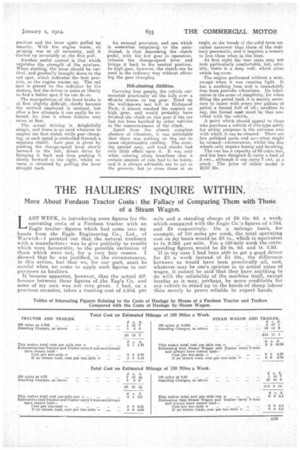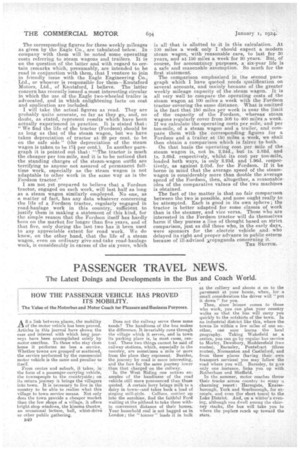THE HAULIERS' INQUIRE WITHIN.
Page 23

Page 24

If you've noticed an error in this article please click here to report it so we can fix it.
More About Fordson Tractor Costs : the Fallacy of Comparing Them with Those of a Steam Wagon.
LAST WEEK, in introducing some figures for the operating cosls of a Fordson tractor with an Eagle trailer—figures which had come into my hands from the Eagle Engineering Co. Ltd., of Warwick—I pointed out that the natural tendency with a manufacturnr waste give publicity to results which were favourable, to the possible exclusion of those which were not, for a very fair reason. I showed that he was justified, in the circumstances, in this action, but that we, for our part, must be eareful when we come to apply such figures to our purposes as hauliers.
It became apparent, however, that the actual difference between these figures of he Eagle Co. and some of my own was not very great. 1 had, on a previous occasion, taken a running cost of 4.50d. per mile and a standing charge of £6 las. 6d. a. week, which compared with the Eagle Co.'s figures of 4.75d. and £5 respectively. On a mileage basis, for example, of 100 miles per we'ek, the total operating cost on my basis would be la Is., which is equivalent to is. 9.32d. per mile. For a t50-mile week the corresponding figures would be £9 9s. 9d. and le. 3.21
If in my case I had been able to get a good driver for £3 a week instead of £1 10s., the difference between us would have been practically nil, and, whatever may be one's opinion as to actual rates of wages, it cannot be said that they have anything to do with the reliability of the machine itself, except insofar as it may, perhaps, be more creditable for any vehicle to stand up in the hands of cheap labour than merely to prove reliable in expert hands.. The corresponding figures for these weekly mileages as given by the Eagle Co., are tabulated below. In company with them will be noted some operating costa referring to steam wagons and trailers. It is on the question of the latter and with regard to certain remarks which, presumably, are intended to be read in conjunction with them, that I venture to join in friendly issue with the Eagle Engineering Co., Ltd., or whoever is responsible for them—Knutsford Motors, Ltd., of Knutsford, I believe. The latter concern has recently issued a most interesting circular in which the use of the Eagle two-wheeled trailer is advocated, and in which enlightening facts on cost and application are included.
I will take the actual figures as read. They are probably quite accurate, so far as they go, and, no doubt, as stated, represent results which have been actually experienced in practice. It is stated that " We find the life of the tractor (Fordson) should be as long as that of the steam wagon, but we have taken depreciation of tractor at 20 per cent. to be on the safe side" (the depreciation of the steam wagon is taken to be 11 per cent.). In another paragraph it is pointed out that: "-The tractor is much the cheaper per ton-mile, and it is to be noticed that the standing charges of the steam-wagon outfit are terrifying to anyone not assured of permanent fulltime work, especially as the steam wagon is not adaptable to other work in the same way as is the Fordson tractor."
I am not yet prepared to believe that a Fordson tractor, engaged on such work, will last half as long as a steam wagon similarly employed. No one, as a matter of fact, has any data whatever concerning the life of a Fordson tractor, regularly 'engaged in road-haulage work in this country,' sufficient to justify them in making a statement of this kind, for the simple reason that the Fordson itself has hardly been on the market for longer than five years, and of that five, only during the last two has it been used to any appreciable extent for road work. We do know, on the other hand, that the life of a. steam wag6n, even on ordinary give-and-take road-haulage work, is considerably in excess of the six years, which is all that is allotted to it in this calculation. At 100 miles a week only I should expect a modern steam wagon, with reasonable care, to MSC for 30 years, and at 150 miles a week for 20 years. But, of course, for accountancy purposes, a six-year life is a safe and reasonable assumption. So much for the first statement.
The comparison emphasized in the second paragraph which I have quoted needs qualification on several accounts, and mainly because of the greater weekly mileage capacity of the steam wagon. It is all very well to compare the operating costs of the steam wagon at 100 miles a, week with the Fordson tractor covering the same distance. What is omitted is the fact that 150 miles per week is near the limit of the capacity of the Fordson, whereas steam wagons regularly cover from 300 to 400 miles a week. If we calculate the operating costs per mile, and per ton-mile of a steam wagon and a trailer, and compare them with the corresponding figures for a Fordson and a trailer at 150 miles a week, we shall then obtain a comparison which is fairer to both. On that basis the operating cost per mile of the steam wagon is, not 2s. 2.24d., but is. 5.82d. and is. 3.68,d. respectively, whilst its cost per ton-mile, loaded both ways, is only 2.23d. and 1.96d. respectively, as against 2.01d. for the Fordson. If it be borne in mind that the average speed of the steamwagon is considerably more than double the average speed of the Fordson, then, altogether, a reasonable idea of the comparative values of the two machines is obtained.
The -fact of the matter is that no fair comparison between the two is possible, and none ought really to be attempted. Each is good in its own sphere ; the tractor is better adapted for some classes of work than is the steamer, and vice versa. Those who are interested in the Fordson tractor will do themselves harm if they pursue a line of thought based on strict comparison, just as did those who, in the early days, were sponsors for the electric vehicle and who delayed its right and proper advance in public esteem because of ill-advised wopaganda concerning it.
THE SKOTCH.




























